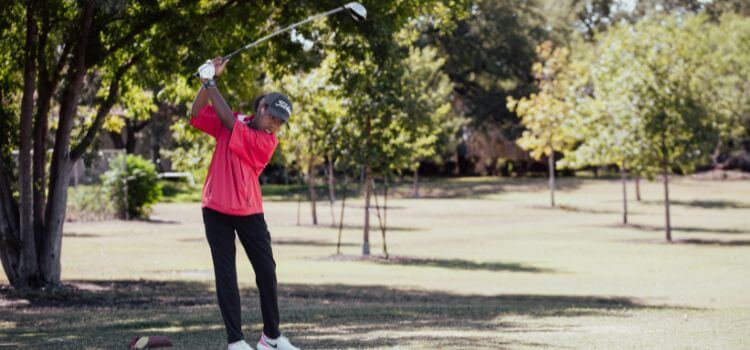As an Amazon Associate, I earn from qualifying purchases.
A backyard putting green is not just a golfer’s dream; it’s a practical investment that can elevate your game and add a touch of luxury to your outdoor space. However, determining the ideal size for this mini-golf oasis requires careful consideration. From space constraints to design preferences, several factors play into defining the perfect dimensions for a backyard putting green.
Benefits of Having a Backyard At Home Putting Green

Convenient Practice Space
Imagine stepping out into your backyard at any time of the day, ready to work on your putting stroke without the hassle of driving to a golf course. A backyard putting green offers unparalleled convenience for honing your skills.
Improved Golfing Skills
Regular practice leads to improvement, and having a personal putting green allows you to dedicate more time to perfecting your technique. This translates to better scores on the course and increased confidence in your game.
Enhancing Property Value
Not only does a well-designed putting green elevate your golfing experience, but it also adds aesthetic appeal to your property. When it comes time to sell, potential buyers may see it as a unique and desirable feature, potentially increasing the value of your home.
Factors to Consider for the Size
Available Space
The size of your backyard will naturally dictate the dimensions of your home putting green. Measure the area you have designated for this purpose to determine how much space you can allocate.
Golfing Goals and Practice Needs
Consider your golfing objectives. Are you looking for a simple practice area, or do you want a green that simulates the challenges of a real course? Your skill level and practice routines will influence the size and design.
Budget Considerations
While a larger putting green offers more versatility, it also comes with increased costs for materials and installation. Factors in your budget constraints when deciding on the size.
Standard Sizes and Recommendations

Common Dimensions for Backyard Putting Greens
Small (Under 300 Square Feet): Ideal for basic putting practice, suitable for beginners or those with limited space.
Medium (300-600 Square Feet): Offers more variety in shot selection, accommodating various putting distances.
Large (Over 600 Square Feet): Provides ample space for a full range of shots, including chipping and pitching.
Recommended Sizes for Different Skill Levels
Beginners: 100-300 square feet
Intermediately: 300-600 square feet
Advanced: 600+ square feet
Design and Layout Considerations
Shape and Contouring Options
The shape of your putting green can vary from a simple rectangle to more intricate designs with curves and angles. Contouring the surface adds realism and challenge to your practice sessions.
Incorporating Landscaping Elements
Blend your putting green seamlessly into the backyard landscape by adding features such as rocks, plants, or water elements. This makes a visually appealing and functional space.
Materials for Construction

Synthetic Turf Options
Synthetic turf is a popular choice for backyard greens due to its durability and low defense requirements. Choose from ingredient textures and pile heights to suit your preferences.
Natural Grass Considerations
For purists who prefer the feel of real grass underfoot, natural turf options are available. However, these require more upkeep in terms of watering, mowing, and fertilizing.
Maintenance of Tips
Cleaning and Upkeep for Longevity
Regularly brush the turf to hold its appearance and prevent matting. Remove debris such as leaves and twigs promptly to avoid damage.
Seasonal Care Practices
Adjust your maintenance routine according to the seasons. For example, aerate the turf in the fall to promote healthy growth, and protect it from freezing temperatures in winter.
Environmental Impact

Sustainability of Materials
Choose eco-friendly materials for your putting green, such as recycled synthetic turf or drought-resistant grass varieties. This reduces water consumption and promotes environmental responsibility.
Water Conservation Practices
Implement water-saving measures, such as installing a rainwater collection system or using smart irrigation technology, to minimize water usage for maintenance.
Safety Measures

Ensuring a Hazard-Free Environment
Make sure the edges of your putting green are secure to prevent tripping hazards. Consider installing padding or soft surfaces around play areas for added safety.
Child and Pet-Friendly Considerations
If you have young children or pets, choose a non-toxic and durable ingredient. Teach them to respect the putting green as a designated play area.
Conclusion
In conclusion, determining the ideal size for a backyard putting green involves a blend of personal preferences, available space, and practical considerations. Whether you opt for a compact green for quick drills or a sprawling oasis for comprehensive practice, ensure it aligns with your needs, maintenance capacity, and design vision. By carefully balancing these factors, you can create a backyard retreat that enhances your golf skills while adding charm to your outdoor living space.
As an Amazon Associate, I earn from qualifying purchases.
Leave a Reply